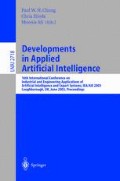Abstract
Conjoint data is data in which the classes abut but do not overlap. It is difficult to determine the boundary between the classes as there are no inherent clusters in conjoint data and as a result traditional classification methods, such as counter propagation networks, may under perform. This paper describes a modified counter propagation network that is able to refine the boundary definition and so perform better when classifying conjoint data. The efficiency with which it uses the network resources suggests that it is worthy of consideration for classifying all kinds of data
Access this chapter
Tax calculation will be finalised at checkout
Purchases are for personal use only
Preview
Unable to display preview. Download preview PDF.
References
Bishop, Christopher M. Neural Networks: A Pattern Recognition Perspective.: Institute of Physics Publishing & Oxford University Press; 1997; (B6):(Fiesler, Emile and Beale, Russell editors. Handbook of Neural Computation. ISBN: 0 7503 0312 3.
Hecht-Nielsen, R. Counterpropagation Networks. Applied Optics. 1987; 26(23):4979–4984.
Moody, J. and Darken, C. J. Fast learning in networks of locally turned processing units. Neural Computation. 1989; 1:281–294.
NeuralWare. Neural Computing; A Technology Handbook for Professional II/PLUS and NeuralWorks Explorer. Pittsburgh, PA: NeuralWare; 1993.
Selim, Shokri Z. and Ismail, M. A. K-means-type algorithms: A generalized convergence theorem and characterization of local optimality. IEEE Transactions on Pattern Analysis and Machine Intelligence. 1984 Jan; 6(1):81–87.
Author information
Authors and Affiliations
Editor information
Editors and Affiliations
Rights and permissions
Copyright information
© 2003 Springer-Verlag Berlin Heidelberg
About this paper
Cite this paper
Pierrot, H., Hendtlass, T. (2003). Using a Modified Counter-Propagation Algorithm to Classify Conjoint Data. In: Chung, P.W.H., Hinde, C., Ali, M. (eds) Developments in Applied Artificial Intelligence. IEA/AIE 2003. Lecture Notes in Computer Science(), vol 2718. Springer, Berlin, Heidelberg. https://doi.org/10.1007/3-540-45034-3_34
Download citation
DOI: https://doi.org/10.1007/3-540-45034-3_34
Published:
Publisher Name: Springer, Berlin, Heidelberg
Print ISBN: 978-3-540-40455-2
Online ISBN: 978-3-540-45034-4
eBook Packages: Springer Book Archive

